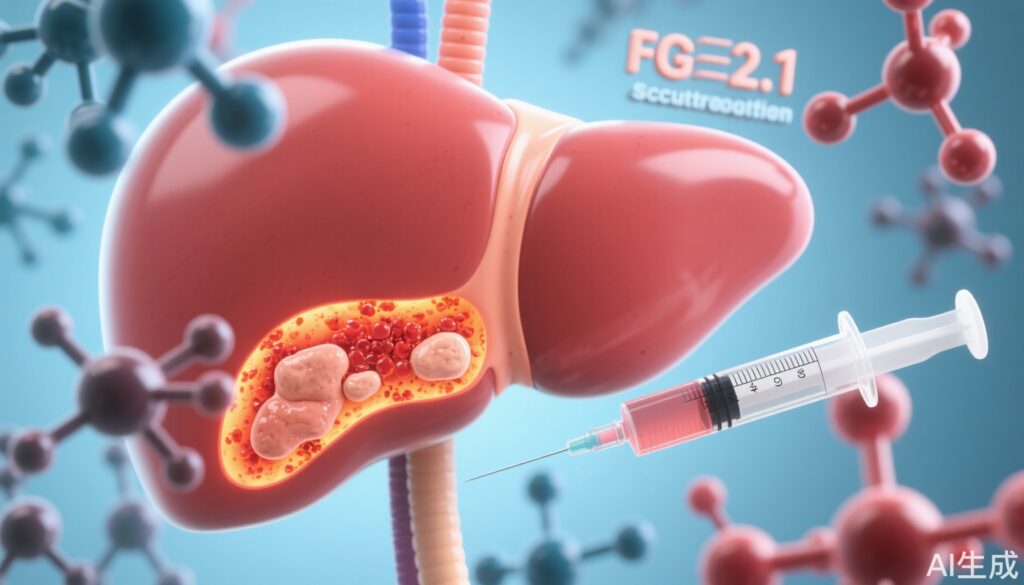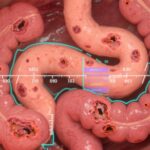Highlights
- Efimosfermin alfa, a long-acting FGF21 analogue, showed a favorable safety and tolerability profile in adults with phenotypic MASH.
- Up to 100% of participants in higher-dose cohorts achieved at least a 30% reduction in hepatic fat fraction after 12 weeks, compared to 7% in the placebo group.
- Gastrointestinal adverse events were the most common side effects, but were mild to moderate and resolved spontaneously.
Clinical Background and Disease Burden
Metabolic dysfunction-associated steatohepatitis (MASH), previously known as nonalcoholic steatohepatitis (NASH), represents a progressive form of fatty liver disease characterized by hepatic steatosis, inflammation, and varying degrees of fibrosis. MASH has become a leading cause of chronic liver disease globally, closely linked to metabolic syndrome, obesity, and type 2 diabetes. The disease is associated with increased morbidity and mortality due to cirrhosis, hepatocellular carcinoma, and cardiovascular complications. To date, there are no approved pharmacotherapies specifically for MASH, highlighting a critical unmet medical need for safe and effective interventions that can modify disease progression and improve hepatic and metabolic outcomes.
Research Methodology
This multicenter, randomized, double-blind, placebo-controlled phase 2a trial (ClinicalTrials.gov NCT04880031) assessed the safety, tolerability, and exploratory efficacy of efimosfermin alfa (BOS-580), a long-acting engineered fibroblast growth factor 21 (FGF21) analogue, in adults with phenotypic MASH. The study enrolled 102 participants aged 18-75 years, each with a body mass index (BMI) of 30-45 kg/m2, across 12 centers in the United States.
Participants were randomized to one of five efimosfermin dosing regimens (75 mg every 4 weeks, 75 mg every 2 weeks, 150 mg every 4 weeks, 150 mg every 2 weeks, or 300 mg every 4 weeks) or placebo, with a 4:1 allocation ratio within each cohort, except for the delayed initiation of the 150 mg every 4 weeks group. Efimosfermin or placebo was administered subcutaneously for a 12-week treatment period. The primary endpoint was safety and tolerability, assessed throughout the treatment and at a 4-week post-treatment follow-up. Exploratory efficacy endpoints included changes in hepatic fat fraction and metabolic biomarkers.
Key Findings
Of the 102 participants (mean age 53 years, mean BMI 36.5 kg/m2), 65 received efimosfermin and 37 received placebo. The majority of participants were male (56%).
Safety outcomes demonstrated that 66% of efimosfermin-treated participants experienced treatment-emergent adverse events (TEAEs) compared with 49% in the placebo group. TEAEs were generally mild to moderate; the most common were gastrointestinal symptoms (nausea, vomiting, diarrhea), affecting 40% of efimosfermin recipients versus 24% of placebo recipients. No treatment-related deaths were reported, and most events resolved spontaneously.
Regarding efficacy, a remarkable 89% (47 of 53 with available data) of efimosfermin-treated participants achieved at least a 30% reduction in hepatic fat fraction at week 12, a reduction associated with improved clinical outcomes in MASH. This effect was dose dependent: 63% (75 mg every 4 weeks), 92% (75 mg every 2 weeks), 90% (150 mg every 4 weeks), 92% (150 mg every 2 weeks), and 100% (300 mg every 4 weeks), compared to just 7% (2 of 30) in the placebo group. The results point to a robust and consistent reduction in liver fat across all dosing regimens, with the strongest effect at the highest dose.
Mechanistic Insights and Biological Plausibility
FGF21 is an endogenous hormone involved in the regulation of glucose and lipid metabolism, energy expenditure, and insulin sensitivity. Preclinical and early-phase clinical studies have suggested that FGF21 analogues can reduce hepatic steatosis, inflammation, and fibrosis. Efimosfermin is engineered for extended half-life, allowing less frequent administration while maintaining therapeutic plasma concentrations. The observed reduction in hepatic fat fraction reinforces the biological plausibility of FGF21-based therapies for MASH, targeting both hepatic and systemic metabolic dysfunction.
Expert Commentary
According to Loomba et al., “The observed safety and efficacy profile of efimosfermin in this phase 2a trial is encouraging and supports continued investigation in larger and longer-term studies.” These results align with growing enthusiasm in the hepatology community for FGF21 analogues as a potential disease-modifying class for MASH. However, experts caution that longer-term data are needed to evaluate effects on liver histology and clinical endpoints such as fibrosis progression and hepatic-related outcomes.
Controversies and Limitations
Notable limitations of this study include its short duration (12 weeks), relatively small sample size, and reliance on imaging-based surrogate endpoints (hepatic fat fraction) rather than histologic confirmation of MASH resolution or fibrosis regression. The high proportion of gastrointestinal adverse events, while typically mild, underscores the need for ongoing monitoring in larger and more diverse populations. Additionally, the study population was restricted to individuals with high BMI, which may limit generalizability to lean MASH patients or those with more advanced fibrosis.
Conclusion
Efimosfermin alfa (BOS-580) demonstrated a favorable safety profile and substantial reductions in hepatic fat fraction in adults with phenotypic MASH over 12 weeks. These results support further clinical development of efimosfermin and other FGF21 analogues as promising therapeutic candidates for MASH, a disease with significant unmet need. Ongoing and future trials will be critical to determine long-term efficacy, impact on liver histology, and clinical outcomes.
References
1. Loomba R, Kowdley KV, Rodriguez J, Kim NJ, Alvarez AM, Morrow L, Jeglinski B, Clawson A, Chowdhury S, Bain G, Odrljin T. Efimosfermin alfa (BOS-580), a long-acting FGF21 analogue, in participants with phenotypic metabolic dysfunction-associated steatohepatitis: a multicentre, randomised, double-blind, placebo-controlled, phase 2a trial. Lancet Gastroenterol Hepatol. 2025 Aug;10(8):734-745. doi: 10.1016/S2468-1253(25)00067-6.
2. Friedman SL, Neuschwander-Tetri BA, Rinella M, Sanyal AJ. Mechanisms of NAFLD development and therapeutic strategies. Nat Med. 2018 Jul;24(7):908-922. doi: 10.1038/s41591-018-0104-9.
3. Abdelmalek MF, et al. Safety and efficacy of FGF21 analogues in nonalcoholic steatohepatitis: A systematic review. Hepatology. 2023;77(4):1079-1090. doi: 10.1002/hep.32799.



